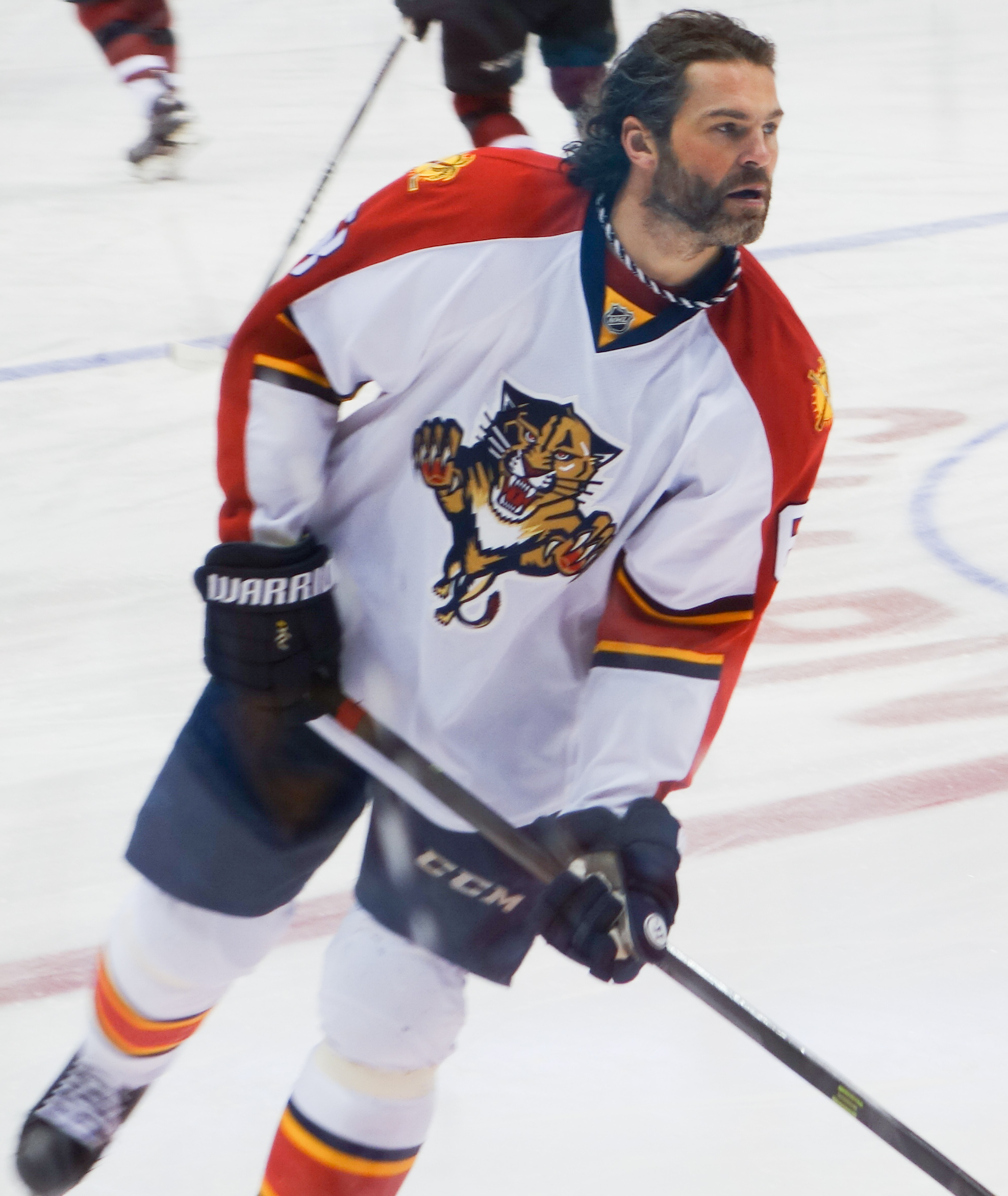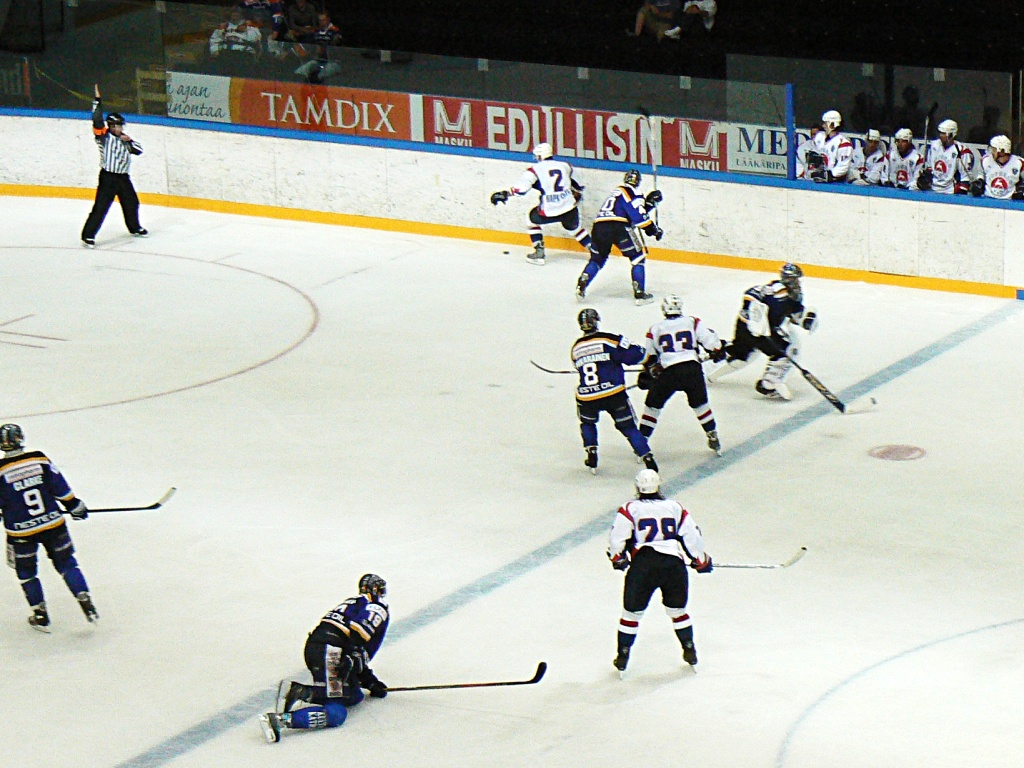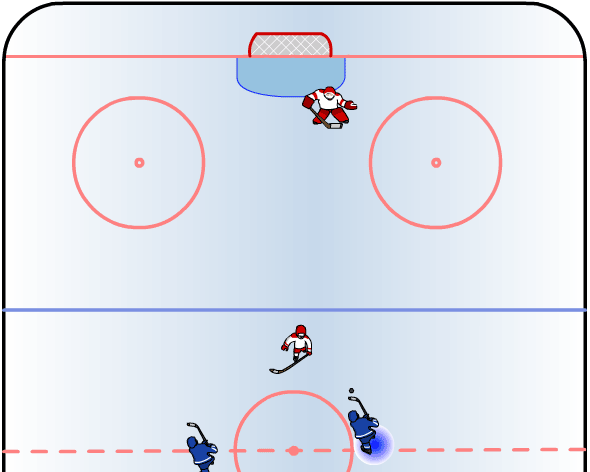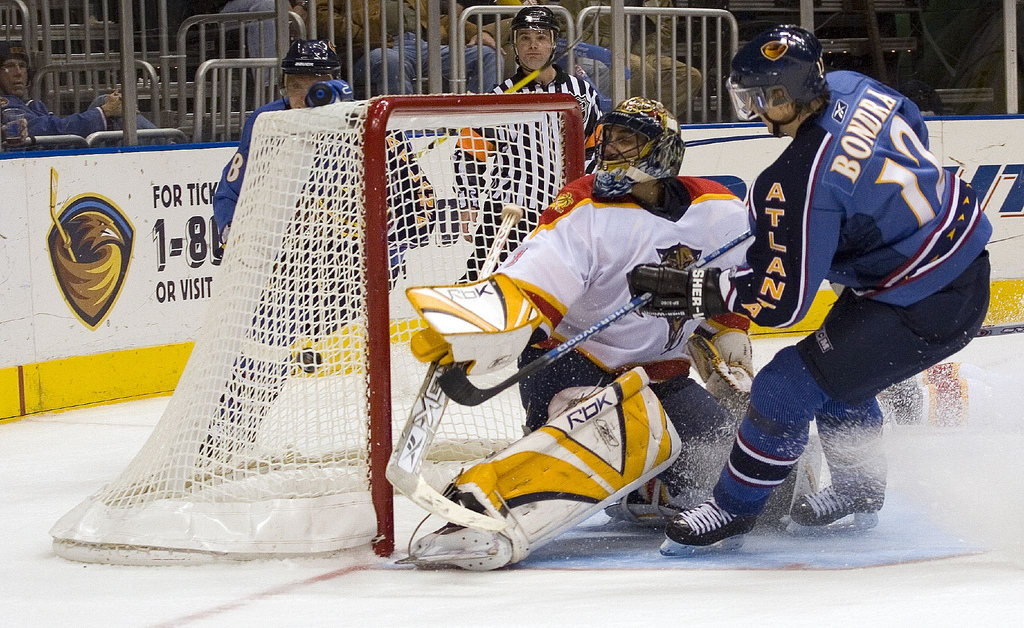|
Larry Gould (ice Hockey)
Larry Stephen Gould (born August 16, 1952) is a Canadian former professional ice hockey player who played two games in the National Hockey League (NHL) for the Vancouver Canucks, with most of his professional career being in the minor International Hockey League. Gould's brother, John Gould, also played hockey, and played over 500 games in the NHL. Playing career Gould started his professional career in 1972 with the Des Moines Capitols of the International Hockey League (IHL). He spent one season there before moving to the Seattle Totems of the Western Hockey League (WHL). His two games with the Canucks game in January 1974: his debut was against the California Golden Seals on January 11, and he played the next night against the New York Rangers before returning to the Totems for the rest of the season. His older brother John was a member of the Canucks at the time. The WHL folded in 1974 and Seattle joined the Central Hockey League, and Gould played one season there, followe ... [...More Info...] [...Related Items...] OR: [Wikipedia] [Google] [Baidu] |
Winger (ice Hockey)
Winger, in the game of ice hockey, is a forward position of a player whose primary zone of play is along the outer playing areas. They typically flank the centre forward. Originally the name was given to forward players who went up and down the sides of the rink. Wingers generally have the least defensive responsibilities out of any position on the ice, however they are still tasked with defensive duties such as forechecking duties or covering the point in the defensive zone. Nowadays, there are different types of wingers in the game — out-and-out goal scorers, checkers who disrupt the opponents, and forwards who work along the boards and in the corners. Often a winger's precise role on a line depends upon what type of role the other winger plays; usually lines will have one more goal-scoring oriented winger and one winger more focused on playing the boards, checking and passing the puck to others to take shots (if a larger player, he will sometimes be called a "power forward ... [...More Info...] [...Related Items...] OR: [Wikipedia] [Google] [Baidu] |
Muskegon Mohawks
The Muskegon Mohawks were a minor league professional ice hockey team in the International Hockey League from 1965 to 1984. Muskegon were Turner Cup champions in 1968. This team was originally named the Muskegon Zephyrs. After the completion of the 1983–84 season, the team was again renamed, this time becoming the Muskegon Lumberjacks The Muskegon Lumberjacks are a Tier I junior ice hockey team in the Eastern Conference of the United States Hockey League. They play in Muskegon, Michigan, at Mercy Health Arena. The Lumberjacks replaced the International Hockey League franchi .... Season-by-season results :::::† indicates replaced mid-season :::::‡ indicates replacement References''Muskegon Mohawks Statistics'' International Hockey League (1945–2001) teams Defunct ice hockey teams in the United States Professional ice hockey teams in Michigan Ice hockey clubs established in 1965 Sports clubs disestablished in 1984 Montreal Canadiens minor league affiliates ... [...More Info...] [...Related Items...] OR: [Wikipedia] [Google] [Baidu] |
1973–74 WHL Season
The 1973–74 WHL season was the 22nd and final season of the Western Hockey League. The Phoenix Roadrunners were the President's Cup The Presidents Cup is a series of men's golf matches between a team representing the United States and an International Team representing the rest of the world minus Europe. Europe competes against the United States in a similar but considerably ... champions as they beat the Portland Buckaroos in five games in the final series. Final Standings bold - qualified for playoffs Playoffs The Phoenix Roadrunners win the President's Cup 4 games to 1. Player statistics Scoring leaders ''Note: GP = Games played, G = Goals, A = Assists, Pts = Points'' Awards References Western Hockey League (1952–1974) seasons 1973–74 in American ice hockey by league {{Icehockey-competition-stub ... [...More Info...] [...Related Items...] OR: [Wikipedia] [Google] [Baidu] |
1972–73 IHL Season
The 1972–73 IHL season was the 28th season of the International Hockey League, a North American minor professional league. Nine teams participated in the regular season, and the Fort Wayne Komets won the Turner Cup. Regular season Turner Cup Playoffs External links Season 1972/73on hockeydb.com {{DEFAULTSORT:1972-73 IHL season IHL International Hockey League (1945–2001) seasons ... [...More Info...] [...Related Items...] OR: [Wikipedia] [Google] [Baidu] |
Niagara Falls Flyers
The Niagara Falls Flyers were two junior ice hockey franchises that played in the top tier in the Ontario Hockey Association. The first, a Junior "A" team existed from 1960 until 1972, and the second in Tier I Junior "A" from 1976 until 1982. Both teams were owned by the Emms Family, and were relocated to Niagara Falls from another city. The Niagara Falls Memorial Arena was home ice to both teams. History The first Flyers team relocated to Niagara Falls from Barrie in 1960. The team was affiliated with the Boston Bruins of the NHL. The Flyers appeared in three Memorial Cups in the 1960s, winning in 1965 and 1968. 1963 Memorial Cup Niagara Falls won the right to play for the Cup by defeating the Toronto Neil McNeil Maroons for the OHA championship, and the Espanola Eagles to win the George Richardson Memorial Trophy as eastern Canadian representatives. The Flyers were runners up to the Memorial Cup in 1963 played at Edmonton's Arena Gardens. They lost in six games to the E ... [...More Info...] [...Related Items...] OR: [Wikipedia] [Google] [Baidu] |
Ontario Hockey League
The Ontario Hockey League (OHL; french: Ligue de hockey de l'Ontario (LHO)) is one of the three major junior ice hockey leagues which constitute the Canadian Hockey League. The league is for players aged 16–19. There are exceptions for overage players of 20 years of age. There are currently 20 teams in the OHL; seventeen in Ontario, two in Michigan, and one in Pennsylvania. The league was founded in 1980 when its predecessor, the Ontario Major Junior Hockey League, formally split away from the Ontario Hockey Association, joining the Canadian Hockey League, Canadian Major Junior Hockey League and its direct affiliation with Hockey Canada. The OHL traces its history of Junior A hockey back to 1933 with the partition of Junior A and B. In 1970, the OHA Junior A League was one of five Junior A leagues operating in Ontario. The OHA was promoted to Tier I Junior A for the 1970–71 season and took up the name Ontario Major Junior Hockey League. Since 1980 the league has grown rapid ... [...More Info...] [...Related Items...] OR: [Wikipedia] [Google] [Baidu] |
Hamilton Red Wings
The Hamilton Red Wings were a junior ice hockey team in the Ontario Hockey Association from 1960 to 1974. The team was based in Hamilton, Ontario, at the Barton Street Arena, also known as the Hamilton Forum. History The Hamilton Tiger Cubs were renamed in 1960 becoming the Hamilton Red Wings as they wanted to gain increased ticket sales to emphasize the affiliation with the parent Detroit Red Wings which dated back to 1953. The team played for 14 seasons before being renamed the Hamilton Fincups as they had an ownership change as well as the partnership with Detroit was terminated in the late 60's. The Red Wings of 1962 were coached by Eddie Bush, and managed by Jimmy Skinner (1954-55 Stanley Cup Champion Coach) . The team finished second overall in the OHA standings, then lost only 1 game in the post-season run to the Memorial Cup. In the playoffs Hamilton defeated the St. Catharines Teepees, Niagara Falls Flyers, and the Metro Jr. A. champs Toronto St. Michael's Majors 4 ... [...More Info...] [...Related Items...] OR: [Wikipedia] [Google] [Baidu] |
Penalty (ice Hockey)
A penalty in ice hockey is a punishment for an infringement of the rules. Most penalties are enforced by sending the offending player to a penalty box for a set number of minutes. During the penalty the player may not participate in play. Penalties are called and enforced by the referee, or in some cases, the linesman. The offending team may not replace the player on the ice (although there are some exceptions, such as fighting), leaving them short-handed as opposed to full strength. When the opposing team is said to be on a ''power play'', they will have one more player on the ice than the short-handed team. The short-handed team is said to be "on the penalty kill" until the penalty expires and the penalized player returns to play. While standards vary somewhat between leagues, most leagues recognize several common varieties of penalties, as well as common infractions. The statistic used to track penalties is called "penalty minutes" and abbreviated to "PIM" (spoken as single w ... [...More Info...] [...Related Items...] OR: [Wikipedia] [Google] [Baidu] |
Point (ice Hockey)
In ice hockey, point has three contemporary meanings. Personal stat A point is awarded to a player for each goal scored or assist earned. The total number of goals plus assists equals total points. The Art Ross Trophy is awarded to the National Hockey League (NHL) player who leads the league in scoring points at the end of the regular season. Team stat Points are also awarded to assess standings (or rankings). Historically, teams were awarded two points for each win, one point for each tie and no points for a loss. Such a ranking system, implemented primarily to ensure a tie counted as a "half-win" for each team in the standings, is generally regarded as British and/or European in origin and as such adopted by the National Hockey League which was founded in Canada where leagues generally used ranking systems of British origin. Awarding points in the standings contrasts with traditional American ranking systems favored in sports originating within the United States where today the m ... [...More Info...] [...Related Items...] OR: [Wikipedia] [Google] [Baidu] |
Assist (ice Hockey)
In ice hockey, an assist is attributed to up to two players of the scoring team who shot, passed or deflected the puck towards the scoring teammate, or touched it in any other way which enabled the goal, meaning that they were "assisting" in the goal. There can be a maximum of two assists per goal. The assists will be awarded in the order of play, with the last player to pass the puck to the goal scorer getting the primary assist and the player who passed it to the primary assister getting the secondary assist. Players who gain an assist will get one point added to their player statistics. Despite the use of the terms "primary assist" and "secondary assist", neither is worth more than the other, and neither is worth more or less than a goal. Assists and goals are added together on a player's scoresheet to display that player's total points. Special cases If a player scores off a rebound given up by a goaltender, assists are still awarded, as long as there is no re-possession by t ... [...More Info...] [...Related Items...] OR: [Wikipedia] [Google] [Baidu] |
Goal (ice Hockey)
In ice hockey, a goal is scored when the puck entirely crosses the goal line between the two goal posts and below the goal crossbar. A goal awards one point to the team attacking the goal scored upon, regardless of which team the player who actually deflected the puck into the goal belongs to (see also own goal). Typically, a player on the team attempting to score shoots the puck with their stick towards the goal net opening, and a player on the opposing team called a goaltender tries to block the shot to prevent a goal from being scored against their team. The term goal may also refer to the structure in which goals are scored. The ice hockey goal is rectangular in shape; the front frame of the goal is made of steel tube painted red (blue in the ECHL because of a sponsorship deal with GEICO) and consists of two vertical goalposts and a horizontal crossbar. A net is attached to the back of the frame to catch pucks that enter the goal and also to prevent pucks from entering it ... [...More Info...] [...Related Items...] OR: [Wikipedia] [Google] [Baidu] |
Season (sports)
In an organized sports league, a typical season is the portion of one year in which regulated games of the sport are in session: for example, in Major League Baseball the season lasts approximately from the last week of March to the last week of September. In other team sports, like association football or basketball, it is generally from August or September to May although in some countries - such as Northern Europe or East Asia - the season starts in the spring and finishes in autumn, mainly due to weather conditions encountered during the winter. A year can often be broken up into several distinct sections (sometimes themselves called seasons). These are: a preseason, a series of exhibition games played for training purposes; a regular season, the main period of the league's competition; the postseason, a playoff tournament played against the league's top teams to determine the league's champion; and the offseason, the time when there is no official competition. Preseason In ... [...More Info...] [...Related Items...] OR: [Wikipedia] [Google] [Baidu] |



